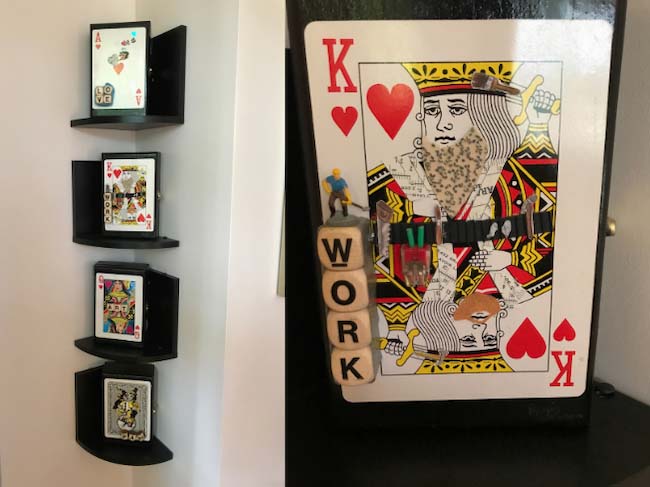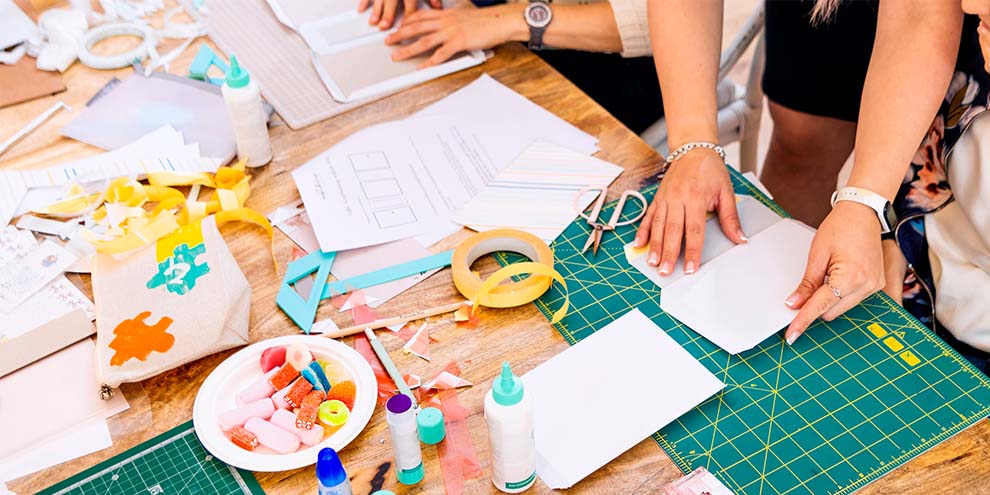Q&A with Regis O’Connor
Editor’s note: Nancy Cox is the founder of Research Story Consulting and former CPG corporate researcher. Her work and play include words, sketchpads, cooking (not baking) and the occasional sock puppet.
Passions, hobbies, healthy distractions and even guilty pleasures – discover how the research community plays and how that plays out in their work life. In the Venn diagram of work and play, what happens when work and play overlap? Research colleagues share their work and play stories in this interview series by Nancy Cox.
Hello to Regis O’Connor, adjunct professor Norwich University; president, O’Connor Analytics
What is the “play” in your life?
Recently, I’ve been making collages. I’ve always made things. I knit. I sew. I make data visualizations. Collage is kind of a data viz but it’s not so much about data, it’s about concept. When I do collages, it’s not just about ripping pages out of magazines or newspapers. My collages are three-dimensional. They include techniques such as sewing.
Like most projects, collaging started with a question. What am I going to do with all this stuff? When I left Mattel and cleaned out my office, I had all kinds of tchotchke stuff. I was taking a class with an artist who made incredible collages. He encouraged me to start my collage with a plain wooden box, like a cigar box. I ended up making a series of four collage boxes about the overlap of power and play, The field of play is about power - whether in mastering a card game, a sport or an instrument.

The first one in the series is the ace of hearts. I started with “Love” because Love trumps all. All the things that come into play where Love is the concept. The next is the king of hearts, “Work.” A lot of people’s play is work. Literally, the case with me as a researcher in the toy industry. The king has a tool belt, sports a sandpaper beard. I turned one of his swords into a house painter’s brush. Inside, Lego® pieces hold up a Hot Wheels® car above diagrams of a radio resistor, snippets of magazines such as a boy playing under the headline “sturdy and active” from an old ad.
The queen is about “Art.” She has a tattered Barbie® inside wrapped in a scarf. There’s sheet music in that one because you can play music. Then the last one is the joker. That’s not my favorite. Because that one is about “Pain,” so I added broken marbles, a broken record, pawns and snakes. Because often power brings pain, play can bring pain as well. With all four, it’s a twist of looking at how play and power intercept.
How has your play influenced your research work?
Play was my business for years at Fisher-Price then Mattel, where I was the director of consumer insights. We talked about play. We analyzed play. We had all kinds of words to describe the components of play. Play is about the discovery, the interactivity – including the feedback from what and who you’re playing with, the sense of accomplishment.
Feedback is an especially strong part of play. In collage or sewing, there’s feedback from the material. When I’m making a data visualization, the feedback dynamics are the components that work together or don’t work together. Feedback can come from the interaction with the data viz itself. Sometimes that might not feel like play. But ultimately, I bring an attitude of play – “I’m going to play with this” sets a different expectation.
In my current work with data visualization, both data viz and collage have all these interesting features to play with. There’s color. There’s white space. There’s shape. There’s texture in the fine details. Not just cross-hatching and shading, although those are useful especially when you need to limit color. But also, the outlining, or not, of shapes is part of the texture. A black heavy outline feels different than no outline. A heavy outline feels hard-edged, graphic. No outline feels softer, more painterly.
The researcher in me asks the same questions when making collages and data visualizations. Now what? So what? What conversations will this provoke? Am I doing something because it looks nice? What do I want the viewer to do differently as a result of spending time with my creation? If your focus is on the “now what?” you’ll know what to leave out and what to leave in.
For instance, I was working on a Tableau project using financial metrics. The data set was the United States by state and territory, so it included Puerto Rico. When I created the data visualization at the state level, I accidentally kept Puerto Rico. I was stunned at the disparity that Puerto Rico had vs. the rest of the data set. This discovery provoked me, to consider “now, what?” and that became a visualization to elevate the awareness of that huge disparity.
What would you tell readers who want to know more about your area of play?
Reach out around you. I had someone show me how to do collage in a studio art class at a community center. I had never, ever drawn anything. Most of the others attending were art teachers. They were so encouraging! Anything you did, they were like “oh, I really like what you did here.” Plus, my instructor was so good at collage, that I thought, well if he does collage then I’ll do what he does. Because I will learn from someone who does something really well. Not to copy but to learn.
There’s a weekly online challenge, called Collage-Spamouflage. They have really interesting submissions.
For collage materials, go to book sales at the library. I look for photographic books and get a bag of books for five bucks. Then I start ripping things out. You have to be willing to break something. You have to rip it. You have to tear it to pieces. And that’s hard. It’s not what we’re taught to do. My father saw me ripping maps out of an atlas and he was appalled. Look, Dad, I’m going to do it again! But not just to be destructive – I was looking for shapes, patterns, colors. I needed the blue streams. Creative destruction.
Collage takes time and thinking. But with all the time, the thinking, the frustrations, it’s all still play.
